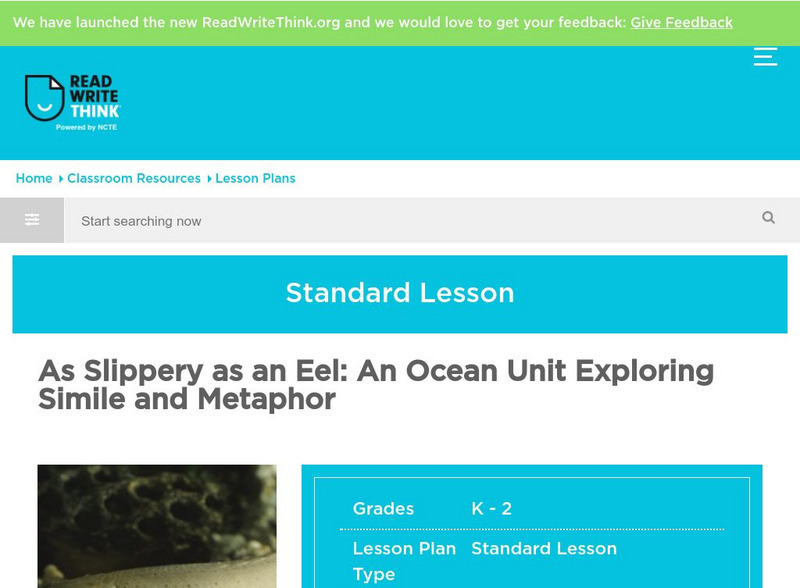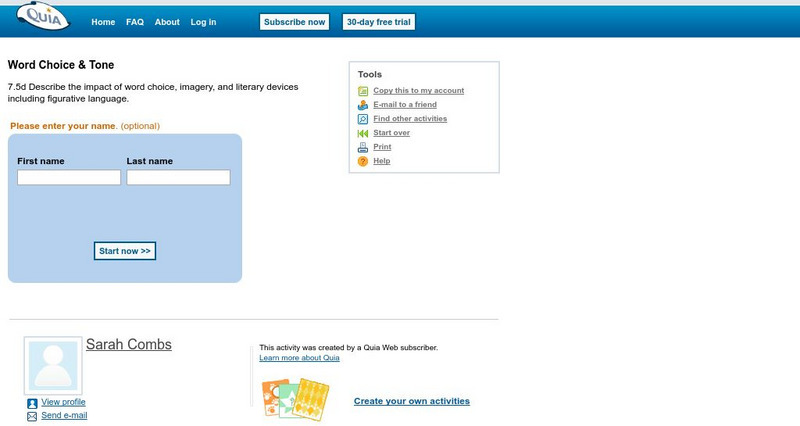Better Lesson
Better Lesson: Go Figure With Figurative Language It Helps With Predicting!
In this lesson plan, students will use figurative language, digital tools, and illustrations to write a story. The teacher will model how to use an app that has onomatopoeia to create a story with a good beginning, middle, and end. A...
Texas Education Agency
Texas Gateway: Imagery and Figurative Language (Grade 6)
This lesson focuses on the use of imagery and figurative language in writing to aid understanding and create images in the mind.
Alabama Learning Exchange
Alex: Plath, Personification, and Figurative Language
This project based activity will use Sylvia Plath's poem, "Mirror", to examine the use of personification and figurative language. The activity may also incorporate the use of technology to produce a multimedia project. This allows...
ReadWriteThink
Read Write Think: Onomatopoeia: A Figurative Language Mini Lesson
Contains plans for a minilesson that teaches about onomatopoeia using Edgar Allan Poe's poem "The Bells." In addition to objectives and standards, this instructional plan contains links to sites used in the lesson as well as assessment...
Texas Education Agency
Texas Gateway: The Language of Physics: Physical Quantities and Units
By the end of this section, you will be able to associate physical quantities with their International System of Units (SI) and perform conversions among SI units using scientific notation; relate measurement uncertainty to significant...
Khan Academy
Khan Academy: The Sound of Language
Can you spot writers' use of alliteration, assonance, and onomatopoeia that add sound effects to their language?
PBS
Wnet: Thirteen: I Have a Metaphor
This lesson not only examines the message of Dr. King, but also the words themselves. This is a lesson in identifying the literary devices that he used in his "I Have a Dream" Speech. It will introduce the following literary devices:...
ReadWriteThink
Read Write Think: An Ocean Unit Exploring Simile and Metaphor
Contains plans for four lessons that teach students about similes and metaphors using ocean themed resources. In addition to objectives and standards, this instructional plan contains links to sites used in the lessons as well as...
Alabama Learning Exchange
Alex: What Are Idioms?
After listening to More Parts by Tedd Arnold read aloud, intermediate school students distinguish between literal and figurative meaning by using a graphic organizer, playing an online game, and incorporating an idiom into their writing.
Utah Education Network
Uen: Discovering Ourselves in Literature and Life
This lesson plan, provided by the International Society for Technology in Education (ISTE), encourages young scholars to evaluate literature in a variety of multimedia formats and answer the question, "Who Am I?," Students are then asked...
CommonLit
Common Lit: Eating Together
CommonLit.org is a wonderful resource to use in a Language Arts classroom. Each story, article or poem is accompanied by guided reading questions, assessment questions, and discussion questions. In addition, students can click on words...
Other
E Tutor, Inc.: Headless Horseman, Heady Author
This lesson for Washington Irving's "The Legend of Sleepy Hollow" explores the author's use of figurative language and includes follow-up activities and additional resources.
Quia
Quia: Word Choice and Tone Quiz
This interactive series of questions assesses students' understanding of the impact of word choice on the tone of a passage. Students will identify the correct tone used in sentences, paragraphs, and poems.
PBS
Pbs: Black Kingdoms of the Nile
A geometry lesson that examines the history and structure of ancient pyramids and engages students in constructing pyramid models. A comprehensive lesson that considers students with diverse learning styles. Math concepts introduced...
Khan Academy
Khan Academy: Style and Technique
Use context to figure out how to use language appropriately--formality, irony, understatement, and overstatement.














